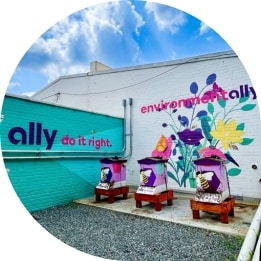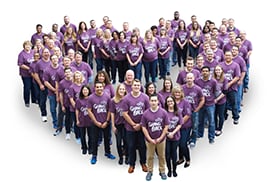
Social Impact
Spark positive change.
A relentless ally for social good.
At Ally, we firmly believe it’s our responsibility as corporate citizens to make a positive social impact on the world around us. This belief is embedded in the very fabric of our business and culture.
In 2017, we began rethinking our commitments to the communities where we live and work. We’re moving beyond giving programs that primarily focus on volunteering and philanthropy to a more strategic approach that supports social and business results. We’re focusing on environmental, social and governance (ESG) issues that differentiate us from our peers, provide a positive social impact and help our stakeholders understand what’s important to us.

Ally 2023 Corporate Social Responsibility report.
Our 2023 Corporate Social Responsibility report provides an in-depth look at our year of progress towards driving lasting change.

3rd
consecutive Outstanding CRA rating
50%
of Ally employees volunteered in communities where they live and work
$58 million +
in Charitable Contributions over the last three years

3rd year
of operational carbon neutrality for Scope 1 and Scope 2 emissions
Read our 2022 Report (PDF), 2021 Report (PDF) and 2020 Report (PDF)

Ally environmental sustainability CDP reporting.
Our commitment to being a relentless Ally goes beyond banking. That’s why we’re focused on conserving environmental resources to help create a sustainable future for our customers, employees, shareholders, and communities we support. To demonstrate our commitment, we submit a yearly climate change questionnaire to not-for-profit environmental reporting organization CDP for an assessment and calculation of our Scope 1, Scope 2, and Scope 3 emissions.
Renewable energy.
Installed solar panels generating enough renewable energy to offset close to 90% of the electrical needs of our building in Lewisville, Texas.
Green Team.
Our network of environmentally-focused volunteers assisted in more than 30 community organizations and served more than 3,500 hours in 2023, up 52% from the previous year.
Electric vehicles.
Installed EV charging stations providing more than 50% of our employees with access to EV chargers.
LEED certification.
Achieved LEED certification in 55% of buildings we own.
Our social impact efforts.
From promoting diversity and inclusion within our company to improving economic mobility in our local communities, our approach to social impact is multifaceted. Read more about where we are focusing our efforts.


